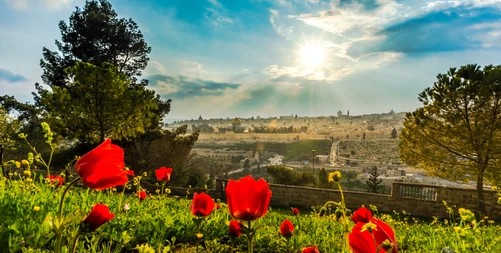
The Seasons of the Holy Land: A Symphony of Nature and Faith
The Holy Land, with its rich history and sacred significance, is a place where the changing seasons play a pivotal role in shaping both the natural landscape and the rhythm of daily life. This region, located at the crossroads of the Mediterranean and the Arabian desert, experiences a Mediterranean climate characterized by hot, dry summers and cool, wet winters. The varying geography—from lush hills and fertile plains to arid deserts and coastal areas—creates a unique diversity in weather patterns, allowing the Holy Land to experience four distinct seasons: spring, summer, autumn, and winter. Each of these seasons brings its own beauty and significance to the land, influencing everything from agriculture to spiritual practices.
Spring in the Holy Land: A Season of Renewal
Spring in the Holy Land is a time of renewal and transformation, typically beginning in March and lasting through May. This season is marked by mild, comfortable temperatures that range from 15°C (59°F) to 25°C (77°F), offering a respite from the cooler winter and a preview of the warmer summer months. The landscape during spring is a stunning tapestry of colors as wildflowers bloom across the hillsides. Anemones, cyclamens, and tulips are just a few of the vibrant flowers that blanket the fields, filling the air with sweet fragrances and adding to the region’s natural beauty.
Beyond its visual splendor, spring in the Holy Land is also deeply significant from a spiritual and cultural perspective. For Christians, it marks the season of Easter, and many pilgrims travel to the Holy Land during this time to participate in religious ceremonies and visit sacred sites. In addition to the religious importance, the season is also a time of reflection and renewal, as the land itself comes alive with new growth after the winter rains. The cool, breezy weather makes it an ideal time for outdoor activities, whether hiking in the mountains of Judea or exploring the historical sites in Jerusalem.
Spring Showers and Agricultural Importance
One of the most vital aspects of spring in the Holy Land is the rainfall, which nourishes the soil and supports the agricultural cycle. While the winter months bring the bulk of the rain, the spring showers are crucial for the growth of crops that will sustain the region throughout the year. Wheat, barley, and other essential grains begin to sprout, while fruits and vegetables like tomatoes, cucumbers, and herbs are planted to thrive in the coming months. For local farmers, these rains are a blessing, ensuring that they can harvest their crops as the year progresses.
The significance of spring’s rainfall cannot be overstated—it’s not just about agriculture; it’s about the life-giving water that nurtures the land and its people. The seasonal rains are essential for the continued growth of the Holy Land, feeding both the land and the communities that depend on its resources. As nature flourishes during this time, there is a palpable sense of hope and rejuvenation in the air, and the people of the Holy Land, alongside pilgrims and visitors, are reminded of the cyclical beauty of life, growth, and faith.
Conclusion
Spring in the Holy Land is a time of vibrancy, both in nature and in spirit. From the blossoming flowers to the agricultural importance of the season, it is a time when the land comes alive and new beginnings are embraced. As the weather becomes more comfortable and the region’s spiritual significance deepens, spring serves as a powerful reminder of the renewal and growth that are woven into the fabric of the Holy Land’s identity.